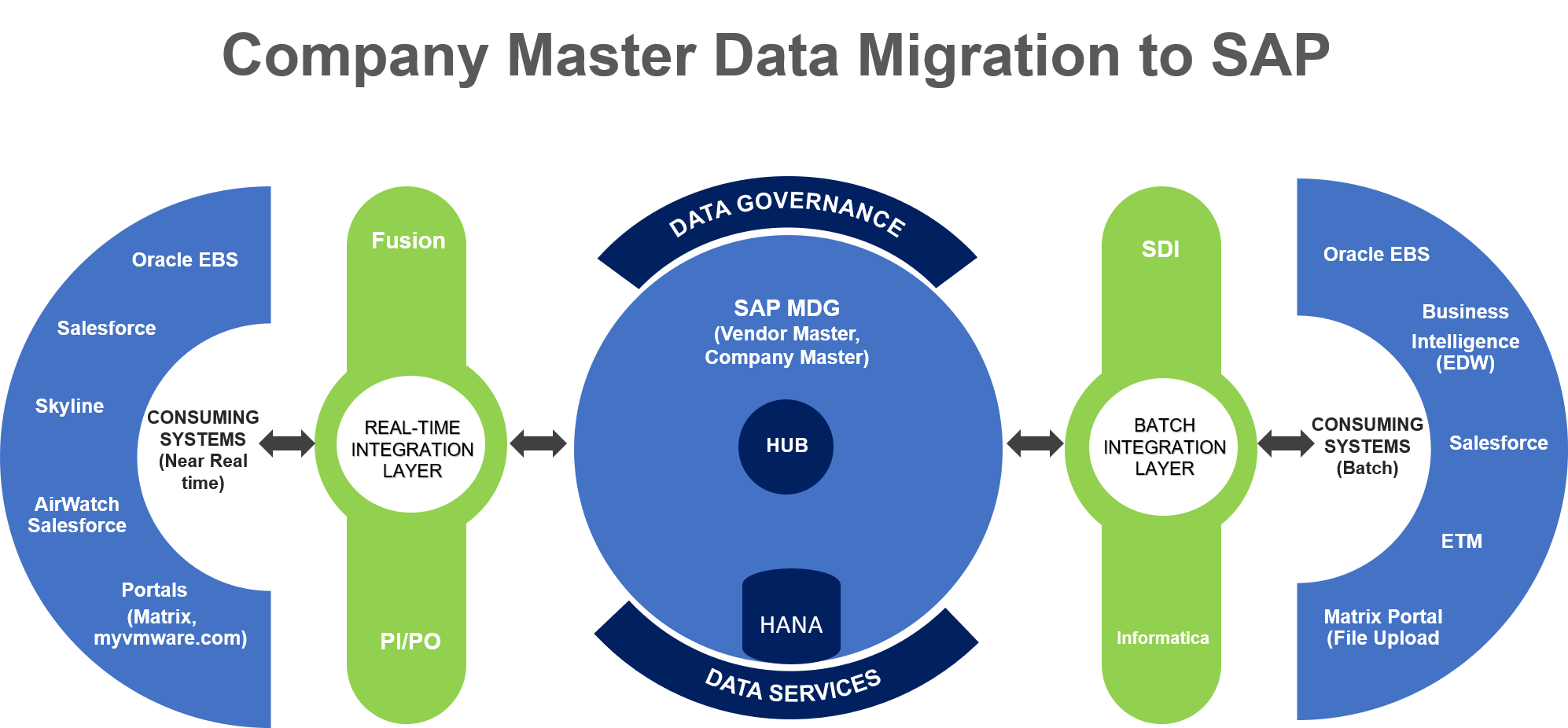by: VMware Senior Director, (CSX) Pankaj Purwar
VMware IT has embarked upon a journey to manage data as a true, reliable corporate asset. Our vision is to create a multi-domain master (MDM) data solution for consuming master data across all VMware systems.
Our first step was implementing a new vendor master on our SAP platform a year ago. Upon completion of this project, we began considering whether to move our company master from a legacy solution to SAP. This would help us address potential security vulnerabilities as well as create a unified multi-domain framework for our data, our goal.
The decision was made to upgrade to SAP from our current platform. This was due to several reasons: avoiding the cost of maintaining dual landscapes and protecting our data against potential security vulnerabilities.
In this blog, I will share our story in migrating enterprise company master data to the SAP platform and how we have improved performance and scalability while reducing costs.
MDM Environment
VMware IT had been using legacy databases for its company data, with integrations into major systems including ERP, CRM, and EDW. Once the decision was made to move this data to SAP, the IT MDM team started preliminary work to better understand the extent of the impact on MDM-related upstream and downstream processes. We began with a proof of concept of the new environment.
The architecture of the new environment was designed to enhance performance while leveraging the benefits of an integrated SAP platform. The company and vendor master domains sit in the SAP MDG hub.
- Near real time data exchange. Oracle EBS, Salesforce, portals (Matrix, myvmware.com), Skyline, AirWatch and Salesforce exchange data using Fusion and PI/PO.
- Batch reporting. Data exchange with Oracle EBS, EDW, Salesforce, ETM, and Matrix portal file uploads are handled by SDI and Informatica.
- SAP HANA, an in-memory database, is used to improve the performance transaction execution and real-time analytics.
We adopted a hybrid agile delivery model to migrate the more than eight million organization and person party records to SAP. The functional effort was broken into chunks and delivered with multiple sprint cycles. Multiple data conversion sprints helped ensure valid and high-quality data. The delivery was executed by in-house VMware resources with help from some external staff.

MDM Benefits
The migration project was completed within an aggressive timeline of five months and at less than 10% of the cost of the previous company master implementation. We have benefitted from this migration in numerous ways:
- Better performance. Our analysis indicates 10X performance improvement for key customer batch jobs. Even near real-time reporting delivers enriched data faster for business consumption. End to end customer data processing performance improved by more than 20% for a better user experience, in part due to SAP HANA in-memory processing.
- Simplified architecture. By moving to a multi-domain platform that supports both company and vendor domains, we were able to converge into single landscape for company and vendor master data domains. This not only saves dual landscape maintenance costs but also leverage multi-domain platform capabilities.
- Better cleansing. SAP DQM has native support for more countries than the previous system. Address standardization for top countries improved, translating to better data quality and increased accuracy in territory assignments. We were able to eliminate the need to manually add business rules for some countries and are in process to eliminate an external software package.
- Better scalability and security. Eliminating the old master data platform not only lowered IT costs but enhanced performance, security, and scalability so IT is better prepared to meet the demands of future data growth.
- Mobile updates. A responsive web framework enables the VMware account services team (Information Innovation Center) to make real-time master data updates from browser. Users can search, view, and modify company hierarchy nodes within a global company and across company master records. Spreadsheets have been replaced by real-time drag and drop functionality, and visual representations of organizational hierarchies. The company hierarchy data is also accessible from mobile phones.
MDM Runs on VMware
IT leveraged VMware products within the private cloud for the development and testing of its core master data technologies (SAP MDG and HANA). The private cloud accelerated our migration process by enabling us to quickly spin up VMs as needed. MDM currently uses four private cloud instances and one production environment.
We use VMware vRealize Operations for proactive monitoring and performance management of our data services. IT was one of the first customers to deploy SAP HANA on vSphere 6.0, fully virtualized with a scale out architecture. This enables us to add capacity as needed to adapt easily and quickly to data growth.
A Unified Landscape
IT is now applying what it has learned in migrating its first two master data sets—vendor and company—to its latest implementation, person master data. Person data is currently in flight to become part of the VMware unified multi-domain data landscape. Our final data master, product, will be evaluated and undertaken sometime in the future. Watch for more blogs that discuss our MDM journey.
VMware on VMware blogs are written by IT subject matter experts sharing stories about our digital transformation using VMware products and services in a global production environment. Contact your sales rep or vmwonvmw@vmware.com to schedule a briefing on this topic. Visit the VMware on VMware microsite and follow us on Twitter.



